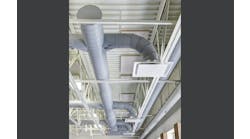Facility managers everywhere are tasked with improving energy efficiency to control costs. Those strides cannot be achieved at the expense of system performance and reliability, or the comfort of the people within those properties.
There are few places where this is truer than in schools and universities. K-12 schools and university lecture spaces must be kept comfortable to maximize student performance.
The question for most schools comes down to budget: What upgrades are needed, and what can be achieved in a retrofit vs. a new system? Similarly, how can new site builds maximize energy efficiency while containing upfront system costs?
Finding the capital for major upgrades or high-end alternative energy systems may be difficult for many schools, but modern control techniques can help improve the efficiency of existing legacy systems and new installations by executing HVAC processes more efficiently.
Fresh Air
The U.S. government mandates that schools meet standards for fresh air in each classroom. Standard airflow measurements signify the cubic feet of fresh air supplied to a room or space each minute. These measurements translate to cfm, or cubic feet per minute.
The ASHRAE 62.1 Standard on Ventilation for Acceptable Indoor Air Quality, in its 2010 edition, ranges from 0.06 of cfm of fresh air per square foot for lecture halls, to as much as 0.18 cfm per square feet for scientific laboratories. Most K-12 classrooms land in the middle at 0.12 cfm per square foot.
Per person, these figures should allow for between 7.5 and 15 cfm depending on the age group and room size. In layman's terms, this means bringing enough outside air into the space to maintain appropriate fresh-air levels. This sounds simple in theory, but how efficiently the school heats and cools that air to create a comfortable environment will affect energy bills noticeably.
Many new schools are being designed with variable air volume (VAV) systems, which direct more or less air to each classroom or zone based on occupancy or load. This is achieved by providing airflow from a central air-handling unit, and opening or closing dampers in VAV boxes to control the amount of air being supplied to each individual zone.
The main air-handling unit, typically installed in a mechanical room, brings in and conditions the fresh air from the outside. It pushes the appropriate amount of flow out to the building depending on how many zones are occupied. These AHUs utilize variable frequency drives (VFDs) to control fan speed based on how much air is needed throughout the building. Classrooms and lecture halls are equipped with VAV boxes capable of releasing more or less air into the room.
The goal is to limit the amount of fresh air to the absolute minimum needed to satisfy guidelines and provide a safe environment. In most cases, the amount of outside air brought into a building correlates directly to energy consumption.
Modulating dampers and air-flow sensors often are utilized to measure and control fresh air intake and usage. The ability to monitor and control the amount of air being exchanged will ensure that a school is following guidelines and operating efficiently.
Meeting Efficiencies
Effectively manage energy use requires an understanding of how the space is being used, which rooms are occupied at what times, and how effectively systems are performing.
Often, schools trying to reduce energy look at retrofits. It can be difficult and costly to replace entire systems in existing buildings. Walls and ceilings are in place, and often the facility design may not be suitable for more modern mechanical systems. Tearing down walls to add new ductwork may be prohibitively expensive.
For these scenarios, it is common to add new monitoring and control devices to legacy equipment. This can enable facility managers to determine how much energy is being used, where it is going, and how to best reduce usage and fix the problem.
The first step is to add monitoring systems that can capture, log and archive data — and subsequently create trends, reports and graphs that demonstrate how the systems are performing and where energy is being used. The installation of metering equipment can help measure energy demand and consumption. Temperature sensors can be installed easily in zones throughout the building to provide an accurate picture of real-time conditions and possible problem areas.
The second step requires studying that information to determine ways to improve the facility in a cost-effective manner. One simple method often used to cut energy usage is to add programmable thermostats to each space. Setpoints can adjust at the end of the day when the classrooms empty, and then re-adjust automatically the next morning when the classrooms are occupied.
Another common practice is to replace legacy control devices with modern control systems that can operate the equipment more efficiently. Newer control systems typically are information-intensive and require a large number of sensors through the facility. These sensors provide access to real-time information, and workers can monitor processes, react quickly to potential problems and support high levels of quality control.
In schools, sensors may be especially helpful in determining which rooms to heat or cool at the appropriate times. A band room or gymnasium may be full one hour and empty the next. Bills multiply when spaces are heated or cooled constantly with no one in the room.
Education institutions typically address this challenge in one of two ways:
•CO2 sensors can provide information on occupancy levels; CO2 levels will increase proportionally with the number of students in the room. These provide the added benefit of signaling dangerous levels, and modern sensors often enable detection, transmission and display of other data (such as humidity and temperature).
•Occupancy sensors can signal when a room is populated. Control systems can be notified when a room is occupied, and then make suitable adjustments to the setpoint temperature and air-flow requirements based on the usual number of bodies expected in that space.
The ability to connect such sensors over RS485, IP and other networks brings another benefit through more efficient use of staff. This is because of remote control and monitoring capabilities that enable staff to gain access to the control system interface from anywhere to make real-time adjustments — and discover and fix problems before they become major issues.
Modern Devices and Sensors
Modern monitoring and control devices can provide the tools necessary to monitor building requirements, processes and performance.
Integrating pulse counters into programmable I/O devices and controllers is an emerging trend that assists in tracking electrical, water and gas consumption. Because most utility meters offer pulse outputs, the inclusion of pulse counters in I/O devices makes it easy to track and manage this usage.
In addition to tracking total energy usage, another helpful application is sub-circuit monitoring to measure power usage in individual electrical circuits. This helps determine how power is being used across a facility. Each sub-circuit typically requires a separate current transducer (CT).
Each CT requires its own input on the I/O device, and this can result in a high number of inputs being needed in larger schools and multi-building university campuses. Modern input devices have a high number of inputs and can make this an affordable proposition.
Modern sensors also have been designed to address needs. Both wired and wireless sensors can be integrated within modern HVAC systems. Sensors can connect to control systems that use both IP or serial networks. An IP-enabled device can pass data directly to the front-end software by using the existing IP network, and even serial enabled I/O devices (RS232 or RS485) can connect to a serial-to-Ethernet gateway to make everything accessible through the building's IP network — reducing costs and providing instant access to the systems from anywhere.
Buildings that need a high number of temperature sensors often are best served with 1-wire designs, which simplify wiring and installation. This technology also eliminates the need for a separate input for each sensor, which reduces hardware costs and makes the system scalable for future expansion.
The built-in addressability of 1-wire chips enables the sensors to communicate to a central controller over a single-cable network, and in a daisy-chained fashion. This provides a more efficient alternative to legacy solutions that require a dedicated "home-run" cable to the controller from each sensor, eliminating the need for multiple wires and multiple A/D input connections.
Adding sensors and devices to measure conditions in individual zones, as well as in centralized mechanical rooms to monitor major equipment such as air-handling units, boilers and chillers, may offer pertinent information to gauge how efficiently the systems are operating — and how effective the systems are at meeting the needs of the facility. The ability to capture that information in the evaluation stage will help management determine if more efficient HVAC equipment and precisely which components, are needed.
Multi-Building Campuses
Colleges and universities, unlike most K-12 schools, must efficiently heat and cool multiple buildings. Each building is unique in terms of resources needed,
Connecting systems and components over IP networks is ideal in these situations. The ability to share information across Ethernet and IP provides an efficient way to collect readings from multiple buildings.
Web-based, front-end software packages enable building managers to use a standard web browser to control and monitor automation systems locally or in remote locations around the world. Visualization and monitoring of real-time data, manual and scheduled setpoint changes, real-time alarming functionality, and reporting and analysis are some of the benefits.
Flexibility in deployment is also key: Setup should be simple, enabling users to connect devices quickly and create watch lists or graphical views for real-time monitoring.
VanOort is president of DataNab, Mantorville, Minn. He can be reached at [email protected].

